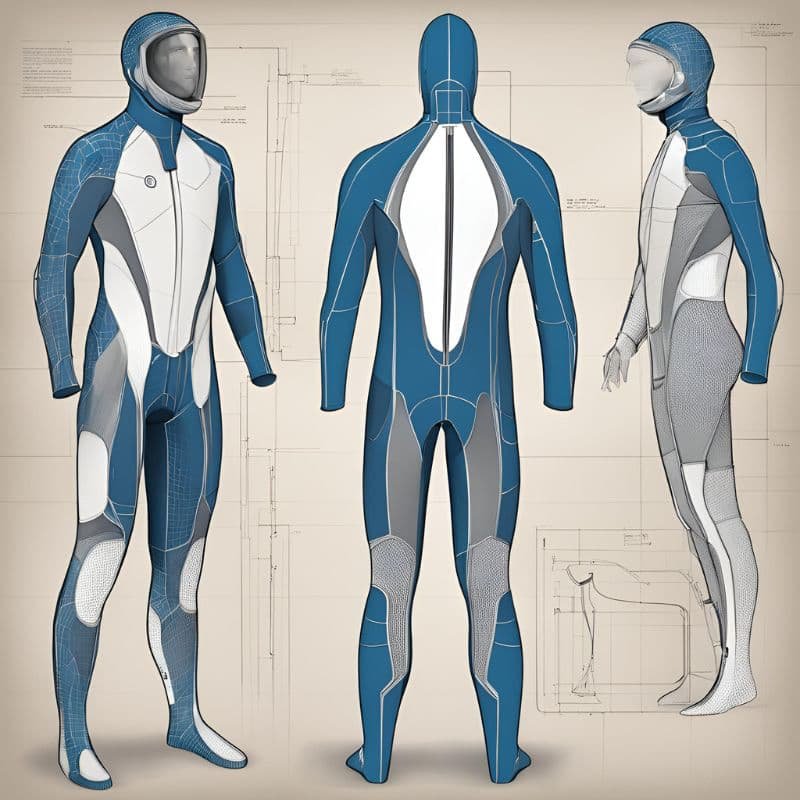
 Roni Essex
Freediver, Spearo, Creator
Roni Essex
Freediver, Spearo, Creator

 Roni Essex
Freediver, Spearo, Creator
Roni Essex
Freediver, Spearo, Creator
Spearfishing, rooted in ancient hunting traditions, has evolved tremendously over the centuries. From simple wooden spears to today’s carbon fiber spearguns, the sport continues to push the boundaries of technology. But where is it headed next? As environmental concerns, material science advancements, and wearable technologies converge, the future of spearfishing gear is poised for dramatic transformations. In this blog post, we will explore a number of possible upcoming technologies and innovations that could reshape the sport of spearfishing in the coming years.
Spearguns are the cornerstone of spearfishing, and they are set to undergo significant changes. Traditional band-powered and pneumatic spearguns may soon be augmented by advanced engineering, potentially leading to new forms of propulsion, targeting systems, and ergonomic design improvements.
Electric-Powered Spearguns: Imagine a speargun that relies on electric propulsion rather than compressed air or rubber bands. Research in other underwater technologies, such as torpedoes and marine drones, shows that electric motors are becoming smaller and more efficient. This opens the possibility of compact electric spearguns that could deliver high power with minimal recoil, offering both beginners and experienced spearos greater control and accuracy.
Electric spearguns could come with adjustable power settings, allowing users to adapt their shots to different species or underwater conditions. Additionally, these guns could store more potential energy than traditional spearguns, enabling longer-range shots without losing speed and penetration power.
Targeting Systems and Ballistic Calculators: With the rise of "smart" technologies, it is only a matter of time before spearguns feature integrated digital targeting systems. These systems could incorporate sensors that calculate distance, angle, and even water current to help the diver make more accurate shots. A heads-up display (HUD) on the mask could project a target reticle in real time, allowing for precision aiming, especially in challenging visibility or fast-moving water conditions.
Additionally, ballistic calculators could be integrated to automatically adjust for factors such as buoyancy, drag, and underwater gravity, providing optimal aim points for each shot. These innovations would dramatically reduce missed shots, making spearfishing both more efficient and humane by minimizing poorly aimed hits.

Image Generated By AI
The diving mask, traditionally a passive piece of gear, could soon become an information hub for spearfishers. Advances in augmented reality (AR) and wearable tech could turn masks into multi-functional devices that enhance safety, efficiency, and user experience.
Augmented Reality and Heads-Up Displays: In the near future, masks with built-in HUDs could become commonplace. These smart masks would display vital information such as depth, dive time, remaining air, and the diver’s compass bearing, all in real time. More advanced versions could include sonar-like systems that detect fish, identify species, and estimate size, using image recognition software to distinguish between targets and protected species.
AR could also provide live feedback on the environment, showing water temperature, current strength, and even mapping underwater topography, helping divers navigate more efficiently. For freedivers, breath-holding statistics and oxygen saturation levels could be displayed on the HUD, improving safety by alerting the diver to critical thresholds.
Integrated Communication Systems: Another future innovation could involve integrating underwater communication systems into masks. Using a wireless network, divers could communicate with each other via voice or text, coordinating strategies, warning each other of dangers, or sharing sightings of target fish.

Image Generated By AI
As the world becomes more aware of environmental challenges, the spearfishing community is also being called to adopt more sustainable practices. One major area for improvement is in the materials used to make spearguns, wetsuits, and other gear. The future will likely see a shift toward more eco-friendly and sustainable alternatives, without sacrificing performance.
Biodegradable Components: One of the most exciting developments in materials science is the creation of biodegradable components that can replace conventional plastics and synthetic rubbers. These materials, derived from organic sources such as algae or cellulose, offer the same durability and flexibility as traditional options but break down naturally over time, reducing pollution in the ocean.
In the future, speargun manufacturers might use biodegradable materials for non-essential components such as handles, straps, or even spear tips, which often need replacing after wear and tear. This would decrease the environmental footprint of spearfishing equipment significantly.
Recycled and Upcycled Materials: Another promising innovation is the use of recycled or upcycled materials in spearfishing gear. Companies are already experimenting with recycled plastics and repurposed fishing nets to create eco-friendly wetsuits and speargun components. This trend will likely accelerate as more brands aim for carbon-neutral or zero-waste production methods.

Image Generated By AI
Wetsuits are critical for spearfishers, especially in colder waters. Traditional wetsuits are made from neoprene, a synthetic rubber that, while effective at insulating, is petroleum-based and environmentally damaging to produce. The future of wetsuit technology lies in both enhancing performance and reducing environmental harm.
Yamamoto Neoprene Alternatives: Yamamoto, a leader in wetsuit material innovation, has already developed bio-based neoprene alternatives such as those made from limestone rather than oil. Future wetsuits could use even more sustainable options, like neoprene made from natural rubber derived from plants or renewable algae-based materials.
Moreover, the insulation properties of wetsuits could be enhanced using aerogel technology, which is already used in aerospace applications. Aerogel is an ultra-light material with excellent thermal insulation, allowing for thinner, more flexible wetsuits that provide the same warmth as thicker traditional wetsuits.
Smart Wetsuits: In the future, we may also see the development of smart wetsuits equipped with temperature-regulating technology. These suits could contain embedded sensors and heating elements that automatically adjust to maintain optimal body temperature based on the water conditions. Smart wetsuits could also monitor physiological data, such as heart rate, oxygen levels, and core body temperature, alerting divers to potential dangers like hypothermia or overexertion.

Image Generated By AI
Fins are essential for efficient movement through water, and innovation in fin design has the potential to further enhance the speed, maneuverability, and endurance of spearfishers.
Adaptive Fins: One exciting development is the potential for adaptive fins that can adjust their stiffness in response to water pressure. Using smart materials or micro-actuators, these fins could become more flexible in shallow water, offering greater maneuverability, and stiffen as the diver descends deeper, providing more power for upward kicks. This flexibility would make the fins more versatile and energy-efficient, reducing fatigue during long dives.
Hydrodynamic Optimization: Hydrodynamic fins could be designed using advanced fluid dynamics simulations to reduce drag and maximize propulsion efficiency. By studying marine animals like dolphins or sharks, researchers could develop fin shapes that mimic the natural efficiency of these creatures, allowing spearfishers to glide through the water with minimal resistance.
In addition to performance improvements, future fins may incorporate biodegradable polymers or recycled carbon fibers, making them not only faster but also more sustainable.

Image Generated By AI
As artificial intelligence (AI) and data analytics continue to permeate every aspect of life, the future of spearfishing gear may also be shaped by these technologies. AI-driven tools could assist spearfishers in making data-informed decisions about when, where, and how to fish.
AI-Enhanced Dive Computers: Future dive computers may feature AI algorithms that analyze the diver’s past performance, environmental conditions, and fish behavior to provide real-time recommendations. Based on historical data, the AI could suggest the best times of day to fish, the optimal depths to target certain species, and strategies for improving breath-hold performance.
Environmental Monitoring: Data-driven spearfishing could also involve sophisticated environmental monitoring systems. AI-equipped dive masks or handheld devices could collect and analyze water quality, temperature, and marine life data to predict where fish are most likely to be found. This would enhance both the efficiency and sustainability of spearfishing, as divers could focus their efforts in areas with higher fish populations while avoiding overfished or protected zones.

Image Generated By AI
As we look toward the future, the concept of a circular economy—where products are designed to be reused, repaired, or recycled—will likely play a crucial role in spearfishing gear innovation. Companies may offer gear that can be easily disassembled, with individual components replaced or repurposed, extending the product's life cycle.
This approach will not only reduce waste but also encourage manufacturers to design more durable, modular products that are easy to maintain and upgrade, ensuring that spearfishers invest in high-quality gear that lasts longer and has a smaller environmental footprint.

Image Generated By AI
The future of spearfishing gear will likely be shaped by a fusion of high-tech innovations, sustainability efforts, and smarter designs. From electric-powered spearguns and smart dive masks to biodegradable materials and AI-driven dive computers, the possibilities are endless. These advancements will not only make spearfishing more efficient and environmentally friendly but will also enhance the experience for both seasoned spearos and newcomers alike.
As technology continues to advance, spearfishing is poised to enter a new era—one where tradition meets innovation, and respect for the ocean’s delicate ecosystems is paramount. The sport will continue to evolve, and those who stay ahead of the curve will not only enjoy greater success in their hunts but will also help protect the underwater world they so passionately explore.